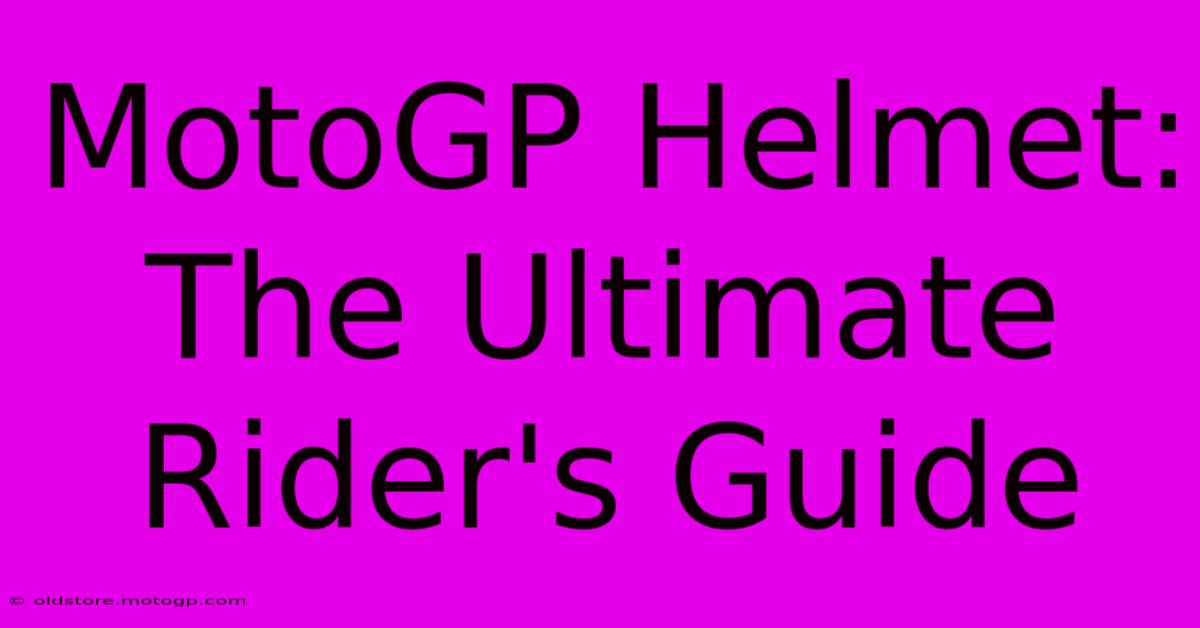MotoGP Helmet: The Ultimate Rider's Guide

Table of Contents
MotoGP Helmet: The Ultimate Rider's Guide
For aspiring and seasoned motorcycle enthusiasts, the MotoGP helmet stands as a symbol of peak performance and unwavering safety. More than just head protection, it's a crucial piece of equipment that directly impacts a rider's comfort, visibility, and ultimately, their ability to perform at their best. This guide delves into the essential aspects of MotoGP helmets, helping you navigate the world of choices and find the perfect fit.
Understanding the MotoGP Helmet Standard
MotoGP helmets are not just any racing helmets; they adhere to stringent safety standards, often exceeding those mandated for street use. These standards, such as ECE 22.06 (in Europe) and DOT FMVSS 218 (in the United States), ensure the helmet meets rigorous testing criteria for impact absorption, penetration resistance, and retention system strength. Look for these certifications when purchasing, as they are your assurance of quality and safety.
Key Features of a Top-Tier MotoGP Helmet:
- Shell Construction: High-performance MotoGP helmets typically use advanced materials like carbon fiber or carbon-aramid, offering exceptional strength-to-weight ratios. These materials provide superior impact protection while remaining lightweight, reducing rider fatigue.
- Liner and Padding: The liner and padding are crucial for comfort and impact absorption. Look for helmets with multi-density liners, which offer varying degrees of protection in different areas of the helmet. High-quality, breathable fabrics help wick away sweat and maintain comfort even during intense riding sessions.
- Visor: The visor is your window to the track. MotoGP helmets often feature high-quality visors with anti-scratch and anti-fog coatings. Some even incorporate tear-off systems for optimal visibility in challenging conditions. The visor's mechanism should be smooth and secure, ensuring a tight, airtight seal.
- Ventilation System: Effective ventilation is crucial for maintaining comfort and preventing overheating, especially during strenuous riding. Look for helmets with multiple intake and exhaust ports, strategically placed to maximize airflow.
- Communication System: Many high-end MotoGP helmets are designed to integrate with communication systems, allowing riders to communicate with their team or fellow riders. This feature significantly enhances rider performance and safety.
- Retention System: A reliable retention system, such as a double D-ring or a micrometric buckle, is essential for ensuring a secure and comfortable fit. The system should be easy to use but also strong enough to keep the helmet firmly in place in case of an accident.
Choosing the Right MotoGP Helmet: A Step-by-Step Guide
Finding the perfect MotoGP helmet requires careful consideration of several factors.
1. Fit and Sizing:
Proper fit is paramount. A helmet that's too tight can restrict blood flow and cause discomfort, while one that's too loose won't offer adequate protection. Always try on helmets before purchasing, and follow the manufacturer's sizing charts carefully. Consider visiting a specialist motorcycle retailer for professional assistance.
2. Budget:
MotoGP helmets represent a significant investment. Set a realistic budget before you start shopping, as prices can vary widely depending on the features and materials used. Remember, safety shouldn't be compromised.
3. Riding Style:
Your riding style will influence your helmet choice. If you're primarily a track rider, you'll need a helmet with features optimized for high speeds and extreme maneuvers. Road riders may prioritize comfort and all-around visibility.
4. Features and Technology:
Consider which features are essential for your needs. Do you require a built-in communication system? Do you prioritize a lightweight design or superior impact protection? Carefully weigh the benefits of each feature against your budget and riding style.
Maintenance and Care of Your MotoGP Helmet:
Proper maintenance ensures your helmet's longevity and optimal performance.
- Regular Cleaning: Clean your helmet regularly using a soft cloth and mild detergent.
- Visor Care: Keep your visor clean and scratch-free using specialized cleaning solutions.
- Padding Care: Allow your helmet liner to air dry after use to prevent the growth of bacteria and maintain hygiene.
- Inspect for Damage: Regularly inspect your helmet for any signs of damage, such as cracks or scratches. Replace your helmet immediately if any damage is found.
Investing in a high-quality MotoGP helmet is an investment in your safety and performance. By carefully considering the factors outlined above and following proper maintenance procedures, you can ensure your helmet provides years of reliable protection. Remember to prioritize safety and always choose a helmet that meets the appropriate safety standards.

Thank you for visiting our website wich cover about MotoGP Helmet: The Ultimate Rider's Guide. We hope the information provided has been useful to you. Feel free to contact us if you have any questions or need further assistance. See you next time and dont miss to bookmark.
Featured Posts
-
Moto Gp Engine Dynamics Understanding The Science Behind The Speed
Feb 19, 2025
-
Moto Gp Arcade Game A Must Play For Racing Fans
Feb 19, 2025
-
Explore Columbus Without The Parking Nightmare
Feb 19, 2025
-
The F1 Starting Grid A Deep Dive Into Strategy
Feb 19, 2025
-
Cota Circuit Days Drive The Iconic Track
Feb 19, 2025
